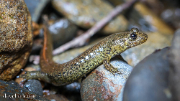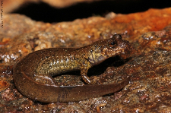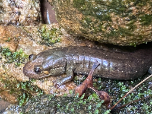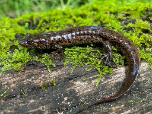Southern Blackbelly Salamander (Desmognathus amphileucus)
Description: A large, robust salamander (3.5 to 8.0 inches in length) having mottled dark brown to black dorsum with lighter rusty brown blotches. Two rows of small, whitish dots occur along the length of each side of the body. A light line occurs from the eye to the corner of the jaw. Bellies are jet black in adults. Tails are triangular in cross-section and are strongly keeled.
Habitat: In or along swift, boulder-strewn mountain streams. Also near waterfalls and places where cold water drips or seeps. Refuges are in rock cevices or in burrows. Usually under rocks in daytime. Sometimes basks in sun on wet rocks.
Range: It is known from southwestern North Carolina, extreme western South Carolina, extreme southeastern Tennessee, and northeastern Georgia.
Found in these States:
GA |
NC |
SC |
TN
Diet: Eats insects, snails, and small salamanders; aquatic prey dominate diet of larvae; adults eat substantial amounts of both aquatic and terrestrial prey. Largely an ambush predator.
Reproduction: Eggs are laid on undersides of rocks or on tree roots in streambed, apparently in headwater tributaries in North Carolina. Lays up to about 60 eggs in June-July, singly or in cluster. Female remains with eggs until hatching. In Virginia, aquatic larvae hatched in August and September, metamorphosed in 2 years; larval period was 3 to 4 years (sometimes 2 years) in North Carolina. In northeastern Georgia, hatching occurred in July, and the larval period lasted 3 or 4 years, depending on location. In North Carolina, age of first reproduction was estimated at 9 to 10 years in females and 7-8 years in males.
Status: Black-bellied salamanders are listed as a species of "Least Concern" on the IUCN Red List. Populations across the geographic range are stable but some populations could be threatened locally by their use as fishing bait. Their populations can also decline from pollution of streams near mining areas as acidification is often a concern.
Taxonomy: Initially described in 1941 as a subspecies of the blackbelly salamander (D. quadramaculatus), a 2022 study found significant genetic divergence within the species, but also found that the name D. quadramaculatus had in fact been coined for the northern dusky salamander rather than the blackbelly salamander. D. amphileucus, already having previously received a name, was uplifted as a distinct species.
»» Kingdom: Animalia - Animals
»» Phylum: Chordata - Chordates
»» Subphylum: Vertebrata - Vertebrates
»» Class: Amphibia - (Amphibians)
»» Order: Caudata - Salamanders
»» Family: Plethodontidae - Lungless Salamanders
»» Genus: Desmognathus
»» Species: Desmognathus amphileucus - Southern Blackbelly Salamander
This article uses material from the Wikipedia article "Nantahala black-bellied salamander", which is released under the Creative Commons Attribution-Share-Alike License 3.0. Content may have been omitted from the original, but no content has been changed or extended.
|













